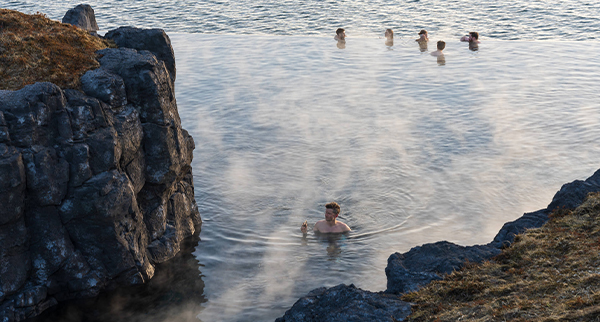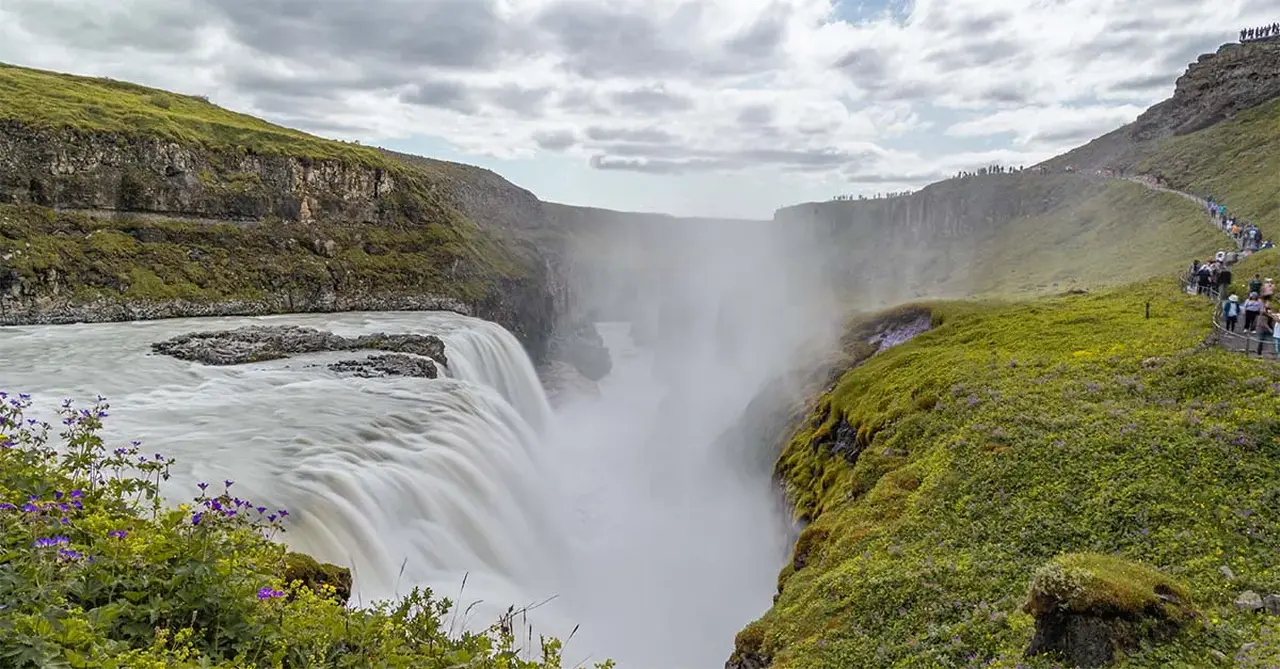You are viewing 2 of your 2 free articles
Green list travel: Iceland
Get the latest on Iceland’s fiery volcano, new spa experiences and hiking across a glacier as Mark Stratton finds out what it’s like in Iceland right now
Click here to download and save as a PDF
Viewed from a glacially shattered hillside, an hour south of Reykjavik, I’m utterly awestruck by the fury venting from the coal-black cone of Fagradalsfjall, Iceland’s newest volcano. It began erupting on March 19 and is set to become the star of Icelandic tourism this summer.
I’m 400 metres away and my face prickles from the furnace heat as Fagradalsfjall emits a sonorous growl, like gravel being tossed around a cement mixer. This is the precursor of an eruption (they are regular) of iridescent blood-orange magma, spewing above the crater rim, then spilling from the cone as if a sweet filling oozing from a fondant dessert.
I’m 400 metres away and my face prickles from the furnace heat
All the while, firebombs hurtle skywards as the escaping viscous flow snakes its way across a blackened, desolate plain. This is not simply a fireworks display. I’m witnessing the very building blocks of the planet as we know it.
In Iceland, Fagradalsfjall is being called the ‘tourist volcano’. Just as Iceland opened to us for holidays on May 17, this incredible spectacle could not be better timed. It’s highly accessible, located on the popular Reykjanes Peninsula, best known for the Blue Lagoon.

A short drive from Keflavik airport, Fagradalsfjall is already finding its way on to new Icelandic tours and promotions. Icelandair, soon to resume daily flights from UK airports, is offering two-night packages from £399 combining the volcano and Blue Lagoon.
“I think Iceland is well positioned to have a fantastic summer because we have what people want during this pandemic – outdoor space to avoid the crowds,” says Arnar Ólaffson, co-owner of Icelandic Mountain Guides. His company has added a Reykjanes Peninsula day trip featuring Fagradalsfjall to its specialist glacier activities.
I undertake an ice-walk across the Solheimajökull glacier
With him, I undertake an ice-walk across the Solheimajökull glacier, a popular tour for those wanting an introduction to using crampons and ice-axes. The glacier surface is surreally beautiful. Whipped up like a frozen meringue, a ghostly hushed landscape of blue-tinged crevasses and streaked, zebra-like, by fallen volcanic ash.
After all these exertions, I’m ready to chill for a bit at the Sky Lagoon, which opened last month. It’s a further addition boosting Iceland’s reputation for geothermal healing and wellness. South of Reykjavik, the sea-facing facility lies behind an unobtrusive yet eye-catching facade of old Icelandic design featuring herringbone walls made from turf.
From its changing room, I wade through a rock tunnel leading into the geothermically warmed lagoon, yet when the steam parts I’m utterly bamboozled by the optical illusion of there being no boundary out into the Atlantic Ocean.
I soak in this mesmerising ocean view
Of course, this is an infinity design, retaining the heated lagoon by a hidden wall. I soak in this mesmerising ocean view, warm to the core, with a glass of fizz to hand from the lagoon’s secreted cave bar.
The two-hour Pure Pass is excellent value, from around £13. I try the ‘seven-step ritual’ that includes steam and sauna rooms, although I was a little hesitant about jumping into the glacial pool. Odd really, as the day before I’d been sweating in front of an active volcano. Such sensory extremes are everyday norms in the Land of Fire and Ice.
Book it
Outdoor specialist Icelandic Mountain Guides, which pays 10%-20% agent commission, offers a day trip called Private Volcano Express, priced £627 in total for a group of one to 12 people. It includes a guided five-hour hike and exploration of the erupting Fagradalsfjall volcano. mountainguides.is
PICTURES: Mark Stratton; Christopher Lund
Read more
x.travelweekly.co.uk/destinations/green-list-travel-madeira">Green list travel: Madeira
x.travelweekly.co.uk/destinations/green-list-travel-gibraltar">Green list travel: Gibraltar
x.travelweekly.co.uk/destinations/whats-new-in-iceland">What’s new in Iceland?




